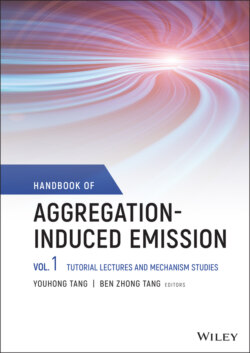Читать книгу Handbook of Aggregation-Induced Emission, Volume 1 - Группа авторов - Страница 18
1.2.3 Ultrafast Insights into Tetraphenylethylene Derivatives
ОглавлениеMolecular motions significantly affect the decay behaviors for AIEgens. Certain excited‐state dynamics require further clarification. Tang and coworkers have developed detailed understanding of excited‐state molecular motions of TPE derivatives and further elucidated the RIM mechanism through the lens of ultrafast spectroscopy [16]. As presented in Figure 1.4, six TPE derivatives with different internal constraints and structural rigidity have been prepared and studied through the first‐principle calculation based on (time‐dependent) density function theory ((TD)DFT) methods.
Different structural rigidities may lead to different freedom of motion and structural variation during the excited‐state decay. Optimized conformations in the S0 state and the S1 state show that all the studied TPE derivatives undergo the elongation of the ethylenic double bond and form the quasi‐double bond after excitation, but the single bonds connecting the peripheral phenyl rings with the central double bond have been shortened. These two types of bond change originate from the weakening of the double bond and the electron density flowing from the double bond to the surrounding single bonds. Meanwhile, the bond variation leads to the twisting of the quasi‐double bond and the phenyl rotors.
Comparison between the S1 and S0 conformations shows that the parent TPE has encountered the largest structural reorganization with the torsion angle of the quasi‐double bond of 56.80° and the torsion angle of the phenyl ring of 29.04°, whereas with decreasing the motion freedom, derivatives show decreased structural changes. The TPE‐6 with double vicinal locking of the phenyl rings only shows the double bond elongation of 0.03 Å and less than 9° twisting of the quasi‐double bond. Hence, the twisting of the quasi‐double bond and the torsion of the phenyl rings have been chosen as the motion coordinates to scan the potential energy surfaces (PES) of the S1 and S0 states. The calculated minimum energy path (MEP) in the ground state of the parent TPE is coupled by the phenyl‐ring torsion from 50° to 90° and the double bond twisting of less than 9° with energy change of less than 7 kcal/mol. There is a transition state connecting two minimum points on the ground‐state PES with the highly twisted quasi double bond. However, the MEP on the excited‐state PES is dominantly associated with the twisting of the quasi‐double bond of 50° due to the significant elongation of the original double bond of 0.12 Å, accompanied by the phenyl ring’s torsion of less than 25°. The PES around the S1,min is shallow with the energy of 60 kcal/mol, which is rather close to the transition state on the ground‐state PES, which will lead to fast decay from S1,min to the ground state.
Figure 1.4 (a) Chemical structures of TPE derivatives with increasing rigidity. (b) Potential energy surfaces (PES) and projections of PES of the S1 and the S0 state of TPE. The MEPs on the S1 and the S0 state are marked as black and white dash line, respectively. (c) Schematic illustration of ultrafast excited‐state decay processes of TPE derivatives and dominant molecules with different timescales.
Source: Adapted from Ref. [16] with permission from The Royal Society of Chemistry.
The ultrafast transient absorption spectra have further revealed the excited‐state decay dynamics through the coupling of the double bond twisting and phenyl ring’s torsion. For the parent TPE, upon absorption of pump light, the excited species will decay from Sn states to the S1 state, through internal conversion within sub‐picosecond, mainly associated with elongation and twisting of the C=C double bond, which can be signalized by the stimulated emission at 1.3 ps. Then, from 1.3 to 3.79 ps, the excitons populated on the emissive state revert back through twisting the quasi‐double bond. After 3.79 ps, the photocyclization intermediate forms associated with the phenyl ring’s torsion with an ultralong lifetime of 159 seconds. With increasing the intramolecular steric congests, TPE‐2 shows similar excited‐state dynamics with the parent TPE, whereas TPE‐3 emits light efficiently within sub‐picosecond even in the dilute solution. The transient emission at 480 nm of TPE‐3 within 1.19 ps has confirmed the ultrafast population on the emissive S1,min, which is consistent with the decrease of the peak at 477 nm on the ultrafast transient absorption spectra due to the stimulated emission between 0.63 and 1.2 ps. The population period takes a longer time as compared to the parent TPE, which indicates that the steric hindrance on the phenyl rings can slow down the twisting of the quasi‐double bond and contribute to the stabilization of the emissive state. Further attaching the alkyl tethers between the geminal or vicinal phenyl rings will largely reduce freedom of motion of the phenyl rings and accelerate the formation of the photocyclization intermediate.
Hence, it can be concluded that TPE derivatives will undergo an ultrafast vibrational relaxation and populate on the S1,min after excitation through the coupled molecular motions of elongation and twisting of the C=C double bond as well as torsion of phenyl rings within the picosecond timescale, after which the photocyclization intermediate will be formed. The dominant time component in this relaxation varies, depending on the conformational rigidity. The increased steric hindrance or structural locking on the parent TPE will hamper the twisting of the quasi‐double bond and stabilize the emissive state to generate efficient light, as in the case of TPE‐3, or directly minimize the motions involving the double bond and the phenyl rings and make the photocyclization intermediate formed on the sub‐picosecond timescale as in the case of TPE‐6. Thus, motions involving the C=C double bond and the formation of the photocyclization intermediate are the dominant pathways for the excited‐state deactivation of TPE derivatives in the solution.
